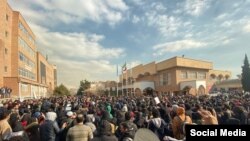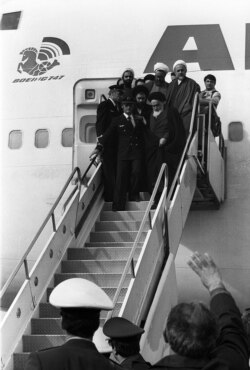The Islamic Republic of Iran is celebrating the 41st anniversary of the 1979 revolution, which replaced the country's constitutional monarchy with clerical rule. However, the change in the form of the government was not all that happened 41 years ago.
The celebration takes place while Iran is struggling with the consequences of several major events in the past 10 weeks and are likely to dramatically affect the Islamic Republic's future, as each one of these events eroded the regime's legitimacy in the eyes of many citizens who come out to protest almost on monthly basis.
In mid-November, millions of Iranians took to the streets protesting against the economic hardships and lack of freedoms that critics squarely blame the ruling clerics for. In recent years, even regime insiders have been increasingly admitting rampant corruption among the ruling elite. Nepotism and political favoritism have also led to mismanagement. These coupled with an anti-American rhetoric and aggressive regional policies have stripped the country of economic opportunities, such as foreign investments.
Angry slogans directly addressed Supreme Leader Ayatollah Ali Khamenei during the November protests. Some reports put the number of those killed by security forces during the violent crackdown at 1,500 while around some 8,000 others remain in jail.
In early January a U.S. drone attack outside the airport in Baghdad killed Khamenei's most favored military commander Qassem Soleimani who was characterized by U.S. President Donald Trump as "the world's biggest terrorist." During Soleimani's funeral around 60 Iranians were killed as a result of mismanagement and chaos.
Five days later the Revolutionary Guard (IRGC) downed a passenger aircraft “unintentionally”, killing all 176 on board and refused to tell the truth for three days about what happened.
All these came as the Islamic Republic has been suffering from its worst economic crisis while the clerical government is still spending the country's diminishing resources on civil wars in other countries such as Syria and Yemen, and on a nuclear program that has created nothing but trouble.
The Islamic revolution started with three demands: "Independence, Freedom and Islamic Republic." Forty-one years on, even regime insiders acknowledge that there is no trace of any one of those "values" left in Iran.
Two military coalitions led by the United States and France have an overwhelming presence in the Persian Gulf. According to many Iranian media reports, in the Caspian Sea Iran has relinquished most of its rights to Russia and its former satellite countries in exchange for Moscow's support at international forums. Russia has been using the The Caspian Sea and the air base in Hamadan at various times to strike targets at other countries while Iranian forces have been doing the foot work for Russia in Syria.
Iranian fishermen have been complaining for a long time about the Chinese sweeping the Persian Gulf leaving nothing for Iranians to catch. In the spring of 2019 Iran called in Iraqi militia Hashd al-Sha'bi possibly to control the angry population following a major flood. These are seen by critics among the population as assaults to national independence.
The situation of freedom in Iran following the Islamic revolution is even worse. The politicians who lost the 2009 allegedly rigged presidential elections are still under house arrest after a decade.
No one has been indicted for killing thousands of prisoners in 1988 and the government refuses to respond to questions about the massacre. Many others have lost their lives during protests in 1999, 2009, 2017, 2018 and 2019 and the government has never acknowledged how many have been killed and arrested during those violent crackdowns.
Meanwhile, according to numerous international reports by the media and human rights watchdogs, Iran has been systematically taking dual nationals hostage for political gain. A former IRGC officer openly suggested that taking hostages should be an outlet for income for the IRGC, prompting the Guard's spokesman to issue an indirect denial.
And as for the Islamic Republic, many former insiders, from Abolfazl Qadyani on the left to Mahmoud Ahmadinejad on the extreme right of the Iranian political spectrum have said that nothing has been left of the Islamism or republicanism of the Islamic Republic.
Financial corruption among clerics and their colleagues in suits particularly during the past year have made many headlines. Even the spokesperson for the Guardian Council has acknowledged lately that both ethical and financial corruptions are major problems in the Islamic Republic.
Both long-time opponents of the Islamic republic and some of its former supporters argue that most of the challenges the country faces are due to the unelected nature of the Supreme Leader and institutions he controls. This has spilled over into the make-up for parliament. In this month’s parliamentary elections the mostly hardliner candidates were approved to run, making the legislature essentially an appointed body.
One of the icons of the Islamic Republic is a picture of Ayatollah Rouhollah Khomeyni the founder of the Islamic Revolution descending the stairs of an airliner that brought him back from exile in 1979. In the original picture, there are a dozen politicians and clerics accompanying him who have been alienated and pushed aside, some even executed over the years. In recent years, after several photoshop attempts to wipe them off the original picture, there is only the Ayatollah left with the captain who is ushering him out.







